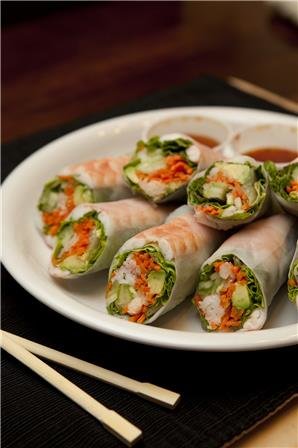
Spring rolls, also named spring pancakes (春饼) or thin pancakes (薄饼), are a traditional festival food among the Han ethnic group. It is popular in China, especially in regions south of the Yangtze River. Spring rolls are made by the following steps: mix white flour with a little water and salt, knead into a dough and bake it into round wrappers, put the fillings — a vegetable and meat filling in most places while a red bean paste filling is used in the northern area of China — on the wrappers, roll the wrappers and fold the two edges right up, then deep-fry the spring rolls until they are golden brown and crispy.
Chinese spring rolls are generally small. A dish of 20 centimeters in diameter can contain more than ten. Spring rolls served in the Chinese restaurants of America have meat fillings, they are as big as hamburgers, and can be a complete meal. Spring rolls were also a dish of the second feast in the Manchu Han Imperial Feast (满汉全席).
History and Origin
According to records, before the Tang Dynasty, everyone made a kind of thin pancake with flour on the day of the Beginning of Spring. People put them in a dish and added special vegetables and fruits; this was called the "Spring Dish (春盘)". It was sent to relatives and friends to show their welcome of spring and its blessing.
In the Tang Dynasty, the Spring Dish was generally decorated with carrots and celery while it had various decorations in rich families. Except for pancakes, there were sauces, baked and salted meat, and varied fried dishes, such as spinach, chives, beansprouts, bean vermicelli and eggs. In the Song Dynasty, the Spring Dish served in the imperial palace was more luxurious.
In the Ming and Qing dynasties, with the development of cookery skills, cooks were able to change flour pancakes into mignon spring rolls. They were not only well-liked by the common folk, but were also famous in the palace. During the Qing Dynasty, when the grand banquet — the Manchu Han Imperial Feast (满汉全席) with 128 dishes — was held, spring rolls were served as one of its nine main pastries.
At present, spring rolls have different varieties, are distinctively shaped and are delicious; they are better than ever before.
Local Features
Spring rolls in Chengdu City
The people of Chengdu consider spring rolls to be non-fried, being made with flour, water and a bit of Chuan salt. The wrappers are made in a pan called "Yun Ban". They fill the wrappers with cold vegetables or fried dishes, such as sliced pork with spring onions or garlic meat. Then mustard powder, soy sauce, vinegar, paprika, processed sesame seeds and crushed peanuts are added as seasonings.
Spring rolls in Xiamen City
Spring rolls are called pancakes in Xiamen. The wrappers are filled with all kinds of ingredients. The main ingredients are bamboo shoots, peas, beansprouts, dried tofu, eggs, fish, shrimp meat, diced meat, oysters and carrots. Dried tofu should be cut or shredded, the thinner the better. After being fried, they can absorb the fluid from the fish, shrimp and meat, which prevents the wrappers from being destroyed by the fluids. Spring rolls like that are crispy, tender, sweet, delicious and rich in nutrients.
Spring rolls in Hong Kong
In Hong Kong, spring rolls are one of the common pastries eaten when people talk over a cup of tea in a teahouse. They are about four inches long and about an inch in diameter. The wrappers are fried until they are golden brown. Inside the wrappers, the fillings are abundant and can include dried sliced mushrooms, shredded pork, dried bamboo shoot slices, vermicelli and agarics. Usually, a dish contains three ingredients. When eating, people use scissors to cut the spring rolls in half and dip them in sauces. There are various spring rolls in Hong Kong. Spring rolls sold in stalls by vendors are two inches or more in diameter. The wrappers are crispier than traditional ones, and the fillings are more abundant, therefore they are very popular as street snacks.

Tidak ada komentar:
Posting Komentar